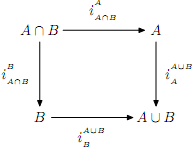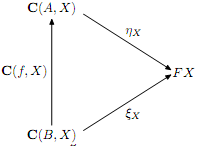Reference no: EM13916762
ASSIGNMENT 1
Question 1:
Recall that a monoid consists of a set, M, with distinguished element e and a binary operation
: M × M → M, (x, y) → x.y
such that for all x, y, z ∈ X
(i) (x.y).z = x.(y.z)
(ii) e.x = x = x.e
Let A be an object of the category C.
Show that C(A, A), the set of all morphisms f : A → A, forms a monoid.
Question 2:
Let ob(C) and ob(Dr) both be the set of all open subsets of Rn for all counting numbers n. For the open subset X of Rn and the open subset Y of Rm with m, n counting numbers, put
C(X, Y ) = {f : X → Y | f is continuous}
Dr(X, Y ) = {f : X → Y | f is r times differentiable}
Show that C and Dr are small categories.
Question 3.
Let A be an object of the category C.
For the object X and morphism f : X → Y of C, define
(i) FAX = C(X, A)
(ii) FAf = f* : C(Y, A) → C(X, A), g → gof
Show that FA, which is also denoted C(, A), is a contravariant functor
FA : C → Set
Let a : A → B be a morphism in C.
For each object X of C, define
αX : C(X, A) → C(X, B), h -→ a o h
Show that
α : FA ⇒ FB, X → αX
is a natural transformation.
Question 4.
Let F be a field.
Put ob(C) = N, the set of all natural numbers. For natural numbers m, n, put
C(n, m) = M(m × n; F)
the set of all m × n matrices with coefficients in the field F. Define composition of morphisms to be matrix multiplication. Show that C is a skeletal category.
Show that F-Vec, whose objects are all finitely generated vector spaces over F, and whose morphisms are F-linear transformations, is a category.
For each finitely generated F-vector space, V, choose a basis BV . Define F : F-Vec → C as follows.
(i) For the finitely generated F-vector space, V, FV = dimF V the dimension of V as vector space over F.
(ii) For the F-linear transformation T : V → W , FT = AT , the matrix of T with respect to the bases BV for V and BW for W.
Show that F is a functor.
Question 5.
Let Ring1 be the category whose objects are unital rings ("rings with 1") and whose morphisms are unital ring homomorphisms, where if R and S are unital rings, then the function f : R → S is a unital ring homomrphism if and only if for all x, y ∈ R,
(i) f (x + y) = f (x) + f (y)
(ii) f (xy) = f (x)f (y)
(iii) f (1R) = 1S
We regard Z and Q as unital rings.
Then the inclusion function ι : Z → Q is a morphism in Ring1.
Let R be a unital ring and take morphisms (that is, homomorphisms of unital rings) f, g : Q → R. Show that f = g if and only if f o ι = g o ι.
Show that Ring1(Q, Z) = ∅, that is, there are no morphisms Q → Z.
ASSIGNMENT 2
Question 1.
Let o and * be group operations on the set G.
Suppose that e ∈ G is the neutral element for both o and * and that for all a, b, c.d ∈ G
(a o b) * (c o d) = (a * c) o (b * d)
Prove for all x, y ∈ G
(i) x * y = x o y
(ii) y * x = x * y
Question 2.
Let ixy: X → Y, x → x be the inclusion function of the subset X of Y into Y. Show that for all sets A, B

is both a push-out diagram and a pull-back diagram in Set, the category of sets and functions between them.
Question 3.
Given sets, X, Y , put
X ∪ Y := (X × {Y} ∪ {X} × Y
and define
inX : X -→ X ∪ Y, x → (x, Y )
inY : X -→ X ∪ Y, y → (X, y)
Show that (X ∪ Y ; inX, inY ) is the coproduct of X and Y in Set.
Question 4.
Given V, W vector spaces over the field F, put
V ⊕ W := {(v, w) | v ∈ V, w ∈ W}
For v, x ∈ V, w, y ∈ W and λ ∈ F, define
(v, w) + (x, y) := (v + x, w + y)
λ.(v, w) := (λv, λw)
Take linear transformations
prV : V ⊕ W → V, (v, w) → v
prW : V ⊕ W → W, (v, w) → w
inV : V → V ⊕ W, v → (v, 0W)
inV : W → V ⊕ W, w → (0V , w)
Show that .V ⊕ W ; prV , prW. is the product of V and W in VecF, the category of vector spaces over F and F-linear transformations.
Show that .V ⊕ W ; inV , inW. is the co-product of V and W in VecF.
Question 5.
Let F : C → Set be a representable functor.
Prove that the object representing F is uniquely determined up to unique isomorphism.
That is, given natural isomorphisms η : C(A, ) ⇒ F , ξ : C(B, ) ⇒ F , there is a unique isomorphism f : A → B such that for each object X, we have a commutative diagram
